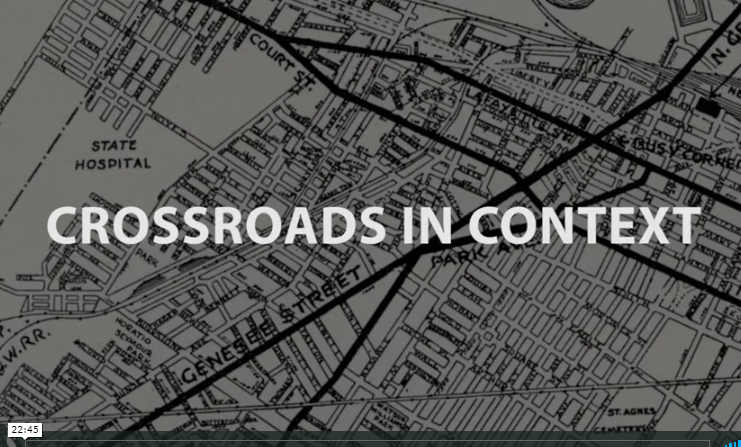
The archive documents pedagogical possibilities of benshi in today’s classroom. This section of the archive includes four components that, together, show the collaborative process among a team composed of: Kyoko Omori as the project leader; Hamilton College students; and some residents of the local community of Utica, NY. Among other things, the project addresses the artistic intellectual, and ethical challenges of learning other peoples histories and cultures and striving to tell their stories with empathy.
Silent Documentary Film
The first component of this section shows the making of a silent documentary film, Crossroads in Context (2017), about refugees in our local community of Utica, NY who are taking ESOL (English for Speaker of Other Languages) classes. Importantly, we intentionally made this movie silent, shooting and editing with live benshi narration in mind, just as historical Japanese filmmakers sometimes did. The documentary was made over three summers, from 2014 through 2016, through collaborations with students from Hamilton College and Doshisha University in Kyoto, and supported by Hamilton’s DHi. The silent film documents weekly English classes at the local art museum in Utica, a project led by April Oswald, Museum Education Director at Munson Williams Proctor Arts Institute. Titled “Shared Traditions: Visual and Language Literacy,” the English/Art program was held for “groups of recent adult refugees learning English as a second language.” In all, a total of twelve Hamilton College students and three Doshisha University students worked on Crossroads over the three years of its making from 2014-2016.
Benshi Performance
The second component of this section features two versions of student benshi performance done alongside Crossroads in Context. One version is by a group of six students who prepared their benshi script collaboratively by learning from individual refugees appearing in Crossroads about their places of origin. The group performed live in front of the Hamilton and local community in 2014 with original music written and performed by the Orochi Ensemble, as described above. The other recording of benshi performance in this section comes from another Hamilton College student, who modified the first group’s script and added her original twists in a studio recording with a different musical score. Thus, I present here two audio versions of student benshi performance for Crossroads in Context.
Interviews
The third section of this segment features a series of interviews that serve as pillars in the Crossroads in Context documentary project and the accompanying benshi performances. These interviews shed light on the project’s core themes of language and personhood from diverse perspectives.
In the first interview, we are introduced to ELL (English Language Learner) students studying at a refugee center in Utica, NY. Here, they share their life narratives, offering insights into their personal experiences and the challenges they have faced.
The second interview delves deeply into the perspectives of the three educators who created the “Shared Tradition” program, an English language and Art class at the Munson Museum in Utica for refugees and recent immigrants. Their discussion touches on the intricate interplay between adapting to American life and reviving their cultural traditions in a new home.
The third interview provides insight from Hamilton students who wrote their scripts and performed as benshi for the documentary, Crossroads in Context. Their reflections offer a nuanced perspective on the project’s impact on their understanding of language, identity, and assimilation.
It is crucial to note that the goal of incorporating benshi into the Crossroads in Context movie was not to appropriate the refugees’ voices and tell their stories on their behalf. Instead, the project aimed to highlight the ethical and political dimensions inherent in assimilation into the English-speaking community.
Please click this link for an interview with ELLs (English Language Learners) at “Shared Tradition.”
Please follow this link for an interview with the teachers at “Shared Tradition.”
Please follow this link for interviews with students who performed benshi alongside Crossroads in Context.
Website
The fourth component introduces a benshi website created collaboratively by two Hamilton students as a digital internship project in 2011-12. Please follow this link for student research created by Sarah Bither ’13 and Melissa Yang ’14 (DHi CLASS Scholars 2011-2012).